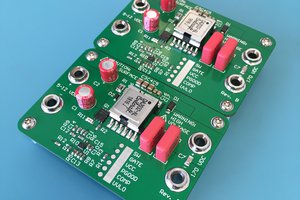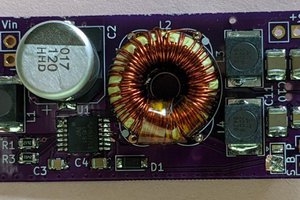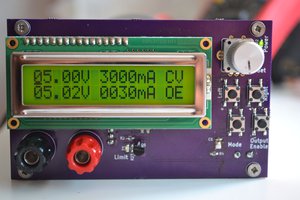What I wanted out of this supply:
- Be small and compact
- output adjustable to 20V
- Use mostly salvaged and recycled components
- display the voltage and current
- Fine adjustment of output voltage
- Adjustable current limiting up to 1A
- Mains supplied
- Linear topology based on a single quad packaged op-amp and all THP construction circuitry
This is my first Power supply based project the other day and thought I'd start with a modest one. Here's how it came out:
Now there are loads of designs out there, so picking is as easy as punching the right terms into google. The most popular of which seemed to be Dave Jones +EEVblog based design, which is based round an LT3080.
A popular design but I wanted to tweak it a little |
Not having one of those in my box I decided to base it on an op-amp and pass transistor instead. So you could say a less polished version of the EEVBlog design.
Hunt for partsAfter a rummage round my parts bin I found a 18V 20VA transformer which would be perfect to power my design. I needed an enclosure and the enclosure I was going to use for my Load project seemed to tick all the boxes: light, small, robust and the transformer fit inside! So that put 2 high value components off the shopping list!
Pass transistor: found a TIP3055. Seemed to be up to the task. The next high-ish value item was the heatsink. The transistor may have to dissipate up to 25W (18x1.41 = 25.38V x 1A = 25W and a bit, I'm assuming full load at near 0V output).
Then looking at the enclosure, the answer was staring me in the bleedin' face! I know working out the case thermal resistance was going to be a brain ache, so I didn't bother! Its a big chunk of metal with a large-ish surface area on the top! I just went with my gut - admittedly that's really not what your supposed to do, but if it didn't work then I was confident I could figure something out!
Other parts: well there are always resistors and caps, but I need a quad packed op-amp: LM324 - yep got one of those! Also a good power supply is based on a decent voltage reference. I didn't want to use a Zener as a reference as their temp coe. and initial accuracy can be poor and after some careful sorting of my parts I found a couple of AD680's. Very nice! Good temp coe. and initial accuracy!
The temperature in my garage can range from bloody freezing to quite comfortable in the space of a day and I'd rather not have my output be dictated by the weather!
Testing the theoryAs with all designs, you first get some testing done. Using SIMETRIX I started testing some designs and observing their performance.
I went through loads of versions - this is version 5 |
My main hurdle was figuring out why my output voltage was so noisy. Then it became apparent I'd not thought about how my voltage feedback was working. Originally the feedback to my voltage error amp (X2) came directly from the output of the supply. When running the simulation and observing the output I first thought that I needed some filtering in my voltage feedback (C3) as from the response I got:
When you think your on the right track, you sometimes find yourself still going in the wrong direction! |
But after looking at the design I was basing mine on, it was clear what I had done wrong! So corrected the feedback and removed C3. I then found that the output became much more stable!
Further simulation also showed that my output needed some regulation current at low voltages and some damping in the voltage amp feedback. Below is a revision of schematic version 5 (above) with the constant current source I1 set to step through different values of regulation current (0-10mA) and C3 is now a 47uF cap connected to the non-inverting input of X4:
V5 rev1, C3 is now 47uF and position moved and I1 will step through on simulation |
Firstly I wanted to see how the output voltage responded to different regulation currents. So I firstly I ran a transient simulation without C3 and set the source V4 (my reference) so that I would get approximately 1V output, and obtained the following:
As it can...
Read more » Tron9000
Tron9000






 James Wilson
James Wilson
 Jonathan Bruneau
Jonathan Bruneau

 Elia
Elia